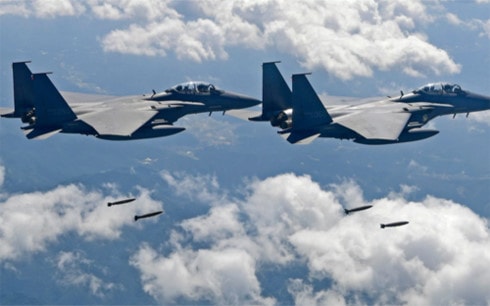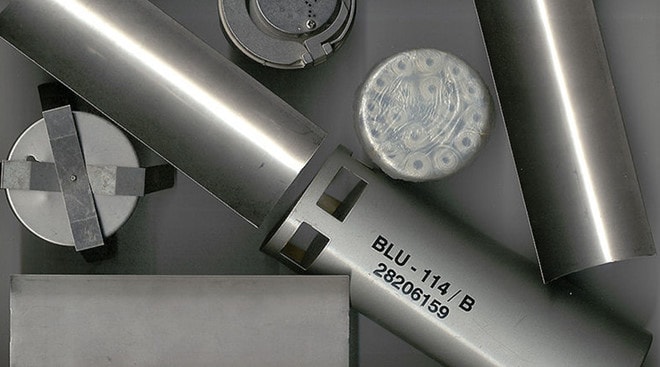Graphite bomb - a weapon that can paralyze North Korea
South Korea recently said it has developed technologies to make graphite bombs, capable of paralyzing North Korea's power grid.
According to a South Korean military official quoted by Yonhap, "all technologies to develop graphite bombs are guaranteed to be safe. We are at a stage where we can make bombs at any time." This information was given amid tensions on the Korean peninsula due to Pyongyang's sixth nuclear test and consecutive missile launches.
Graphite bombs are non-lethal, and are primarily used to disable enemy power grids. Nicknamed “blackout bombs,” these bombs contain chemically treated graphite fibers. When detonated, the graphite fibers cloud into power facilities, cling to power lines, causing short circuits and disrupting the power grid.
 |
| South Korean fighter jets drop bombs during a joint exercise with the US. Photo: AP |
Since graphite is a very good conductor of electricity, its presence will cause the current to flow in multiple directions, causing disturbances and short circuits. The power plant can then explode and cause local power outages in the surrounding areas.
However, unlike an EMP bomb, a graphite bomb is limited to disrupting power lines and is completely incapable of damaging electrical equipment. The graphite bomb is also ineffective against insulated wires and can also be neutralized by shutting down the power grid until the carbon cloud settles.
The bomb was first used by the US Navy in 1991 to cut off the power grid in Iraq during the first Gulf War. It was then used again in Serbia during the Balkan conflict in 1999.
According to research by the Global Security consultancy, in its first use, the graphite bomb “knocked out” 85% of Iraq’s electricity. And in its use in Serbia, the BLU-114/B graphite cluster bomb affected 70% of the area’s electricity supply.
After the use of graphite bombs in Kosovo, NATO spokesman Jamie Shea said the impact of the weapon was largely psychological, as the targeted country felt both literally and figuratively without power. “We can cut off the power grid whenever we need or want,” Shea told the BBC.
The graphite bomb is being developed by South Korea’s Agency for Defense Development as part of Seoul’s preemptive strike program against Pyongyang, called “Kill Chain.” Analysts believe it would be effective in North Korea, which is known to have outdated equipment.
 |
| The BLU-114/B graphite bomb destroyed 70% of Serbia's power grid. (Photo: RT) |
According to Congnghe, if used in North Korea, this type of bomb can completely achieve maximum efficiency because it will make North Korean missiles stay on the launch pad due to power loss, leading to the control computer also losing power. However, North Korea can still use backup power generators.
Therefore, the use of graphite bombs can only disrupt the deployment of North Korea's missile complexes, but cannot completely stop them. Therefore, graphite bombs are only suitable for attacking Pyongyang's missile control centers, or the infrastructure that supports the deployment of missiles.
In addition, this type of bomb can also cause psychological effects on Pyongyang's civilian infrastructure. In the past, when attacked with graphite bombs, it took Iraq up to 24 hours to restore its power system.
According to VOV citing a 2016 article in the Korea Times, the strengthening of South Korea's arsenal also includes the Korea Air and Missile Defense Program (KAMDP), which is tasked with detecting and shooting down any nuclear weapons aimed at the country.
The program was originally scheduled to be completed by mid-2020, but South Korea has accelerated the schedule in the face of North Korea's rapidly evolving nuclear weapons program.
Meanwhile, on September 20, the Korea Herald quoted US Defense Secretary James Mattis as saying that the US possesses a "kinetic" weapon that can be used against North Korea without causing harm to the capital Seoul. However, Mr. Mattis did not reveal specifically what that secret weapon is.
The New York Times later reported that the US Department of Defense has long pursued a top-secret program to develop kinetic weapons. This is a concept that refers to a type of extremely fast missile, very difficult to intercept and does not need to carry a warhead, but can destroy a large target quickly with the energy created when colliding at high speed.
According to Vietnamnet
| RELATED NEWS |
|---|

